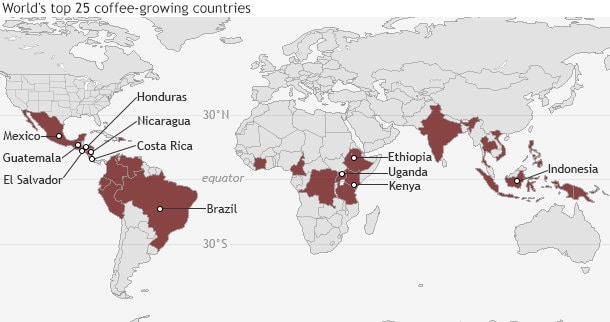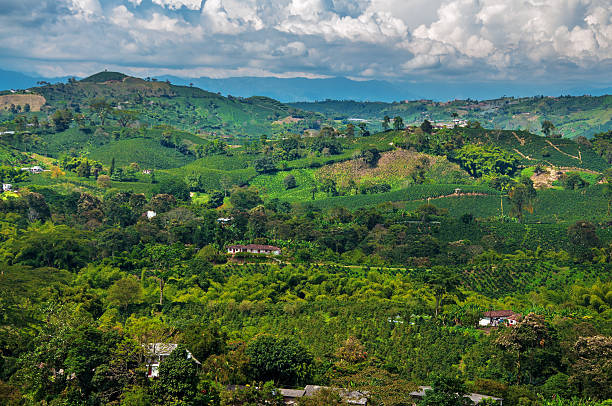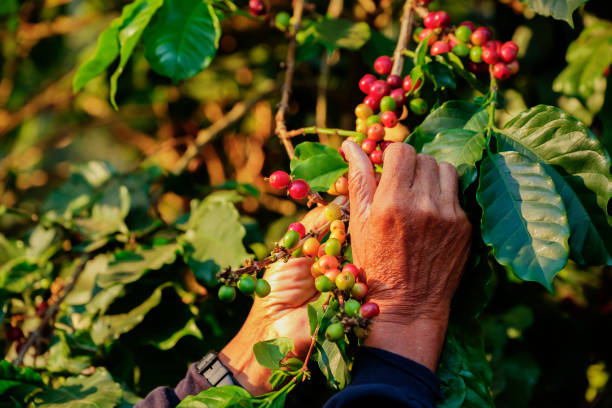Coffee is the world’s most popular beverage, but where do the coffee beans come from? The answer lies in the so-called “coffee belt.” This region stretches from Ethiopia to Mexico, where over 50% of the world’s coffee is grown. Here, different climates and soils provide ideal conditions for cultivating this hearty bean.
Table Of Contents
−- What is a coffee belt?
- Where is the coffee belt located?
- How did coffee become so popular in the coffee belt?
- Which countries are part of the coffee belt?
- What are the ideal conditions for growing coffee?
- Why does coffee grow better in the coffee belt than in other parts?
- The coffee belt: A perfect coffee growing environment
- What is the difference between the coffee belt and other coffee-growing regions?
- How has climate change impacted the coffee belt?
- What can we do to support sustainability in the coffee belt?
- Conclusion
What is a coffee belt?
The Coffee Belt is a fictional band that circles the globe around the Equator and encompasses all of the world’s coffee-growing regions. However, it primarily focuses on Asia, Africa, South America, and Central America.

According to the National Coffee Association, coffee is grown between 25 degrees north of the Equator and 30 degrees south, a range that almost entirely overlaps the Tropics.
It is sometimes referred to as the Bean Belt or Coffee Zone and is known for producing some of the world’s best coffee.
The climate in this region is perfect for growing coffee – warm temperatures, plenty of rainfall, and high altitudes are all essential factors for producing quality coffee beans.
While all these regions have a tropical climate, their lands have unique characteristics that influence the flavor profiles of the coffee they produce.
Where is the coffee belt located?
The coffee belt is an imaginary loop around the planet, stretching from Central America to Papua New Guinea and lying between 25°N and 30°S. It passes through Central and South America, Asia, and Africa and includes Burundi, Congo, Ethiopia, Ivory Coast, Kenya, Rwanda, and Tanzania.
This area has ideal conditions for cultivating coffee, making it the beverage’s birthplace. The difference between the Coffee Belt and other coffee-growing regions is that its climate provides a more consistent environment for growing coffee than other locations.
How did coffee become so popular in the coffee belt?
Coffee’s commercial production began in Yemen when beans from Ethiopia, traditionally considered the home of coffee and where coffee grows wild, were brought in before the 15th century. Both countries are located inside the coffee belt.
Which countries are part of the coffee belt?
The coffee belt stretches across many countries, including Peru, Uganda, Guatemala, Nicaragua, China, Malaysia, Ivory Coast, Costa Rica, Tanzania, and Papua New Guinea. In Central America, some of the countries that are part of the coffee belt include Costa Rica, Guatemala, Honduras, Mexico, Nicaragua, Panama, and El Salvador.
These countries have ideal conditions for growing coffee due to their tropical climates. The coffee belt is a great example of how the environment can play an important role in producing goods.

What are the ideal conditions for growing coffee?
Coffee is a crop that thrives in temperate or tropical climates. Optimal growing conditions for Arabica beans, the most popular variety of coffee, involve subtropical regions at high altitudes of 16-24°.
It is important to maintain a balance between rainy and dry seasons while keeping the temperature between 20°-27°C. Coffee also grows best in a warm, tropical climate with ample sunshine, no frost, and soil enriched by volcanic ash. Growth is most rapid when the day temperature is over 32°C in the Arabian Peninsula.
Why does coffee grow better in the coffee belt than in other parts?
Even within a single continent, different regions or farms within a region can produce very different coffees. This is because the characteristics of coffee are associated with the terroir in which the grapes are grown, just as the characteristics of wine are associated with the terroir in which the grapes are grown.
Like growing the best plants for your garden zone at home, coffee has specific requirements to thrive. Milder temperatures, higher humidity, rich soil, and, in some cases, altitude are examples.
High, mountainous regions with the perfect balance of sun, clouds, and day/night temperature differences can provide ideal growing conditions for this Arabica coffee. But, of course, there is also a rainy season in most coffee belts.
The coffee belt’s geographical position is unique in that;
- It receives enough rain and has distinct dry seasons.
- The climate is somewhat sunny, with calm and stable temperatures.
- There are sufficient altitudes for coffee plants to thrive.
- The soil is ideal for growing coffee plants.
The coffee belt: A perfect coffee growing environment

Temperature
Temperature is the first requirement needed to develop good coffee. Coffee plants do not flourish in cold climes, preferring temperatures ranging from 73°F to 82°F. This temperature range aligns with the tropics’ typical year-round temperature of 70°F–80°F.
Humidity
Humidity is another essential requirement in coffee cultivation. Coffee plants constantly require between 50 and 70 percent relative humidity for optimum yields.
Soil
Soil quality isn’t unique to the climate and ecosystems of the coffee belt, although several coffee belts countries, such as Ethiopia, Costa Rica, and Nicaragua, have much of it. Coffee thrives on nitrogen-rich soil, and high-nutrient-density places, such as volcanic runoff, are ideal for cultivating high-quality coffee.
Elevation
Higher altitudes are better for growing coffee, such as Arabica. High-quality specialty coffee is often grown at elevations ranging from 3,500 to 5,000 feet above sea level. Unfortunately, some types do not do well at high elevations. However, this is the exception rather than the rule.
Coffee grown at higher elevations is often of higher quality and is more in demand among specialty coffee connoisseurs. High-altitude coffee is brighter and fruitier than lower-altitude coffee, and it also keeps fresher for longer due to its increased density.
Certain flavors are generally linked with specific continents and regions.
Africa
- Burundi: chocolate, grassy, low acidity, full body
- Congo: low acidity, full-body, chocolate, intense, tobacco, nutty, earthy, vanilla, spicy
- Ethiopia: full-body, cherry, chocolate, earthy, creamy, blueberry or medium body, herbal, flowery, nutty
- Ivory Coast: medium body, nutty, chocolate, low acidity, earthy spicy
- Kenya: full-body, floral, zesty, citrus, herbal
- Rwanda: medium body, floral, chocolate, nutty
- Tanzania: medium body, earthy, spicy, woody
- Uganda: full body, creamy, chocolate, vanilla
- Yemen: full-body, wine, chocolate
Asia and Southeast Asia
- Bali: medium body, low acidity, earthy, nutty, creamy, vanilla, chocolate, pine
- India: medium body, medium acidity, earthy, spicy, tropical fruit
- Java: full-body, chocolate, low acidity, nutty, creamy
- Myanmar: light body, fruity, complex, medium acidity, floral
- Papua New Guinea: medium body, medium acidity, earthy, milky fruity, spicy, nutty
- Sumatra: full body, intense, gritty, earthy, woody, low acidity
- Vietnam: low acidity, medium body, woody, spice, vanilla, bitter
Island regions
- Dominican Republic: medium body, medium acidity, sweet, mild, caramel
- Hawaii: medium body, complex, deep, floral, fruity, vanilla
- Jamaica: low acidity, medium body, mellow, tobacco, sweet
- Puerto Rico: medium body, nutty, creamy, smoky, buttery, low acidity, sweet
Central America
- Costa Rica: medium body, nutty, citrus
- El Salvador: medium body, red fruit, medium acidity, citrus, chocolate
- Guatemala: can be spicy, fruity, smoky, earthy or delicate, floral, chocolate, sweet
- Honduras: medium body, crisp, light-bodied, orange, spicy, nutty, caramel
- Mexico: heavy body, low acidity, bright, milk chocolate, fruity, lively
- Nicaragua: medium body, mild acidity, chocolate, hazelnut, vanilla, pear
- Panama: zesty, lively, lemongrass, spicy, herbal
South America
- Bolivia: light body, caramel, chocolate, can be flowery and fruity
- Brazil: full body, low acidity, milk chocolate, fruity, spicy, floral
- Colombia: medium body, medium acidity, citrus, fruity, nutty
- Ecuador: light/medium body, medium acidity, fruit, floral, caramel, nutty
- Peru: light body, medium acidity, spice, chocolate, nutty, sweetness, earthy

What is the difference between the coffee belt and other coffee-growing regions?
The Coffee Belt is unique because it is home to most of the world’s coffee production. It is distinguished from other coffee-growing regions due to its ideal climate and soil conditions.
The Coffee Belt is the only region where Arabica varieties of coffee can be successfully grown, with its cool and wet climates providing the perfect environment for Arabica cultivation.
In comparison, other coffee-growing regions outside of the Coffee Belt often have climates that are too hot or too dry for Arabica production. This makes the Coffee Belt an especially important region for the global production of high-quality Arabica coffee.
How has climate change impacted the coffee belt?
Climate change has had a drastic impact on the Coffee Belt. Rising temperatures due to global warming have shifted the lands suitable for growing coffee outside the traditional Coffee Belt, with around ¾ of the region no longer having suitable growing conditions or lands for growing coffee by 2050.
In all three climate scenarios, the number of regions suitable for growing coffee declined by 50 percent. This significant decline could potentially cause serious social and security risks, disrupting the fragile relationship between coffee growers and consumers. We must take action to protect the Coffee Belt and support sustainability in this region.
What can we do to support sustainability in the coffee belt?
At Greener Beans, we believe that sustainability must be at the heart of the coffee industry, and that’s why we’re committed to making sustainable shopping easy and rewarding. As part of our mission, we are working to tackle the coffee supply chain’s key issues with our Coffee LENS sustainability ambition. But we can’t do it alone – we need everyone to join in and help support sustainability in the coffee belt. Here are some of the ways you can help make a difference:
- Support local farmers – buy directly from farmers or cooperatives who are dedicated to sustainable practices.
- Shop responsibly – only buy ethically-sourced, organic, and fair-trade certified coffee.
- Support sustainability initiatives – look for businesses actively working to protect and preserve the environment in the coffee belt.
- Spread awareness – share what you know about climate change and its effects on the coffee belt with your friends and family.
- Donate – many organizations and charities are actively working to support sustainable practices in the coffee belt. Consider donating to any of these causes to help make a difference.
Conclusion
The coffee belt is another term for the expanse of land between the Tropics of Cancer and Capricorn with perfect growth conditions for coffee. The coffee belt encompasses nearly every major coffee-producing country.
Coffee is difficult to grow since it requires exact temperature, humidity, and soil quality to reach its full potential. However, these factors are vital in determining the coffee’s flavors.
This is what makes coffee so fascinating to explore. We notice minor intricacies in flavor notes when we sip coffee from different world regions. Learning about these geographical factors establishes a connection between what we experience and what nature prescribes.
Disclaimer: This post contains affiliate links, which means I may receive a small commission, at no extra cost to you, if you make a purchase using these links. Remember to support us by purchasing through the Amazon/Walmart/Impact Radius links provided. Last update on 2024-04-23 / Affiliate links / Images from Amazon Product Advertising API
Disclosure: No compensation or free products were received in exchange for writing this review.

Editorial Staff
The editorial staff at Crazy Coffee Crave is a team of coffee enthusiasts & Baristas who enjoy the one thing we all think about as soon as we get up in the morning. Trusted by thousands of readers worldwide.





